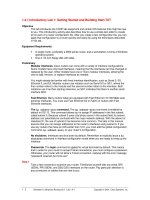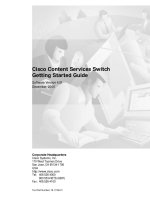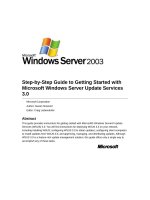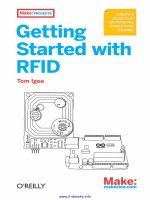Getting started citrix® provisioning services 8591 pdf
Bạn đang xem bản rút gọn của tài liệu. Xem và tải ngay bản đầy đủ của tài liệu tại đây (8.82 MB, 134 trang )
Getting Started with Citrix®
Provisioning Services 7.0
An example-packed guide to help you successfully
administer Citrix® Provisioning Services
Puthiyavan Udayakumar
professional expertise distilled
P U B L I S H I N G
BIRMINGHAM - MUMBAI
Getting Started with Citrix® Provisioning Services 7.0
Copyright © 2014 Packt Publishing
All rights reserved. No part of this book may be reproduced, stored in a retrieval
system, or transmitted in any form or by any means, without the prior written
permission of the publisher, except in the case of brief quotations embedded in
critical articles or reviews.
Every effort has been made in the preparation of this book to ensure the accuracy
of the information presented. However, the information contained in this book is
sold without warranty, either express or implied. Neither the author, nor Packt
Publishing, and its dealers and distributors will be held liable for any damages
caused or alleged to be caused directly or indirectly by this book.
Packt Publishing has endeavored to provide trademark information about all of the
companies and products mentioned in this book by the appropriate use of capitals.
However, Packt Publishing cannot guarantee the accuracy of this information.
First published: January 2014
Production Reference: 1200114
Published by Packt Publishing Ltd.
Livery Place
35 Livery Street
Birmingham B3 2PB, UK.
ISBN 978-1-78217-670-1
www.packtpub.com
Cover Image by Jarek Blaminsky ()
Credits
Author
Puthiyavan Udayakumar
Reviewers
Jack Cobben
Project Coordinator
Ankita Goenka
Proofreader
Mario Cecere
Vikash Kumar Roy
Indexer
Acquisition Editors
Rekha Nair
Rubal Kaur
Mary Jasmine Nadar
Commissioning Editor
Priyanka S
Technical Editors
Kapil Hemnani
Siddhi Rane
Faisal Siddiqui
Copy Editors
Sarang Chari
Brandt D'Mello
Adithi Shetty
Graphics
Yuvraj Mannari
Production Coordinator
Arvindkumar Gupta
Cover Work
Arvindkumar Gupta
Notice
The statements made and opinions expressed herein belong exclusively to the author
and reviewers of this publication, and are not shared by or represent the viewpoint
of Citrix Systems®, Inc. This publication does not constitute an endorsement of any
product, service, or point of view. Citrix® makes no representations, warranties or
assurances of any kind, express or implied, as to the completeness, accuracy, reliability,
suitability, availability, or currency of the content contained in this publication or any
material related to this publication. Any reliance you place on such content is strictly
at your own risk. In no event shall Citrix®, its agents, officers, employees, licensees,
or affiliates be liable for any damages whatsoever (including, without limitation,
damages for loss of profits, business information, or loss of information) arising out
of the information or statements contained in the publication, even if Citrix® has been
advised of the possibility of such loss or damages.
Citrix®, Citrix Systems®, XenApp®, XenDesktop®, and CloudPortal™ are trademarks
of Citrix Systems®, Inc. and/or one or more of its subsidiaries, and may be registered
in the United States Patent and Trademark Office and in other countries.
About the Author
Puthiyavan Udayakumar has more than six years of IT experience with
expertise in Citrix, VMware, Microsoft products, and Apache CloudStack. He has
extensive experience in designing and implementing virtualization solutions using
various Citrix products, VMware Products, and Microsoft products. He is an IBM
certified Solution Architect and Citrix certified Enterprise Engineer along with
more than 15 certifications in infrastructure products. He is the author of the book,
Getting Started with Citrix® CloudPortal™. He holds a master's degree in Science
with a specialization in System Software from Birla Institute of Technology and
Science, Pilani, a bachelor's degree in Engineering through SKR Engineering College
from Anna University, and National award from the Indian Society for Technical
Education. He presented various research papers in more than 15 national and
international conferences including IADIS (held in Dublin, Ireland) followed by
the IEEE pattern.
I would like to dedicate this book to my beloved mom,
Dr.K. Mangayarkarasi, dad, Dr.P.Udayakumar, brother,
Mr.Kathiravan, and to his family.
Big thanks to Packt Publishing to get this book published!
About the Reviewers
Jack Cobben, with over thirteen years of systems management experience, is no
stranger to the challenges that enterprises can experience when managing large
deployments of Windows systems and Citrix implementations. He writes in his
free time for his own blog www.jackcobben.nl and is active on the Citrix support
forums. He loves to test new software and share the knowledge in any way he can.
You can follow him on twitter via @jackcobben.
Vikash Kumar Roy has been associated with associated with IT for close to
15 years. In his 15-year IT career, he worked on various platforms and domains.
Currently, he is an expert on end-user computing. Prior to this, he designed and
delivered solutions on server virtualization.
I would like to thank my guru and my boss who helped me
learn and deal with every challenge I faced with my current
and previous job.
www.PacktPub.com
Support files, eBooks, discount offers, and more
You might want to visit www.PacktPub.com for support files and downloads related to
your book.
Did you know that Packt offers eBook versions of every book published, with PDF and ePub
files available? You can upgrade to the eBook version at www.PacktPub.com and as a print
book customer, you are entitled to a discount on the eBook copy. Get in touch with us at
for more details.
At www.PacktPub.com, you can also read a collection of free technical articles, sign up for a
range of free newsletters and receive exclusive discounts and offers on Packt books and eBooks.
TM
Do you need instant solutions to your IT questions? PacktLib is Packt's online digital book
library. Here, you can access, read, and search across Packt's entire library of books.
Why Subscribe?
•
Fully searchable across every book published by Packt
•
Copy and paste, print, and bookmark content
•
On demand and accessible via web browser
Free Access for Packt account holders
If you have an account with Packt at www.PacktPub.com, you can use this to access PacktLib
today and view nine entirely free books. Simply use your login credentials for immediate access.
Instant Updates on New Packt Books
Get notified! Find out when new books are published by following @PacktEnterprise on
Twitter, or the Packt Enterprise Facebook page.
Table of Contents
Preface1
Chapter 1: Introduction to Citrix® Provisioning Services 7.0
5
The background of Citrix® Provisioning Services 7.0
5
High-level logical flow of Citrix® Provisioning Services
6
®
Architecture of Citrix Provisioning Services 7.0
9
Provisioning Service License server
10
Provisioning Service Database server
10
Provisioning Service Admin Console
10
Shared storage service
10
Active Directory Server
11
Network services
11
®
Citrix Provisioning Server
11
Terminology11
Citrix® Provisioning Service farms
12
®
Citrix Provisioning Service stores
12
Citrix® Provisioning Service sites
12
Citrix® Provisioning Service vDisk
12
®
Citrix Provisioning Service vDisk modes
13
Citrix® Provisioning Service vDisk pools
13
13
Citrix® Provisioning Service vDisk Update Management
Citrix® Provisioning Service write cache destination
13
System requirements
14
Summary16
Chapter 2: Installing and Configuring Citrix® Provisioning
Services 7.0
Installing Citrix® Provisioning Server using GUI
Installing Citrix® Provisioning Services using the
command-line interface
17
17
23
Table of Contents
Installing Citrix® Provisioning Services Console 7.0 using GUI
23
Configuring Citrix® Provisioning Server 7.0
27
Configuring Provisioning Services using the
command-line interface
38
Summary39
Chapter 3: Managing Citrix® Provisioning Disk
41
Chapter 4: Operating Citrix® Provisioning Services 7.0
63
Organizing a principal target device
41
Checking the readiness of the master target device's hard disk
42
The principal target device's BIOS configuration
45
Server network adapter BIOS configuration
45
Deploying the master target device application and
operating system updates
46
Allocating a vDisk to the target device
50
Properties of the principal target device
50
Dealing with the bootstrap files and boot devices
55
Summary62
Managing and operating a farm
Operating sites
Managing and operating stores
Managing and operating target devices
Operation over target devices
Creating a new target device object in the Provisioning Service database
Setting the target device as the template for this collection
Copying and pasting target device properties
Booting target devices
Checking the target device's status via Console
Sending messages to target devices
Enabling/disabling a target device
Managing and operating the device collections
Device management operations
Creating a device collection
Importing a device collection
Deleting a device collection
Booting target devices within a collection
Managing views
Managing and operating the provisioning servers
Operation tasks in the Provisioning Service task
Copying and pasting server properties
Deleting a server
Starting, stopping, or restarting Provisioning Services on a server
Showing the server connections
[ ii ]
63
68
71
75
82
82
84
84
84
85
85
85
86
88
88
88
89
89
89
91
94
95
95
96
96
Table of Contents
Load balancing the target devices on a server
Checking for vDisk access updates
Manually configuring Provisioning Servers
97
97
97
Operating vDisks
97
Creating vDisks
98
Creating vDisk images
99
Summary100
Chapter 5: Upgrading Citrix® Provisioning Farm and vDisk
Upgrading the existing Provisioning Services farm
The Hyper-V method
Installing Hyper-V Integration Services (optional)
101
101
102
103
The Reverse Imaging method
Updating vDisks
Manual vDisk creation
Automatic vDisk creation
Managing update tasks
Merging of the vDisk from the existing disk
104
105
106
106
107
108
Troubleshooting reference articles
Summary
110
Promoting the update version
110
Index113
[ iii ]
Preface
Citrix® Provisioning Services fulfills the need of virtual disk streaming over
networks. The product allows virtual disks to be provisioned and reprovisioned in
real time from a single shared disk image or from a dedicated disk. The product also
aids to avoid the necessity to manage and patch discrete systems. Instead, all image
management is through the master image, and this results in a reduction of power
usage, system failure rates, and security risks.
Citrix® Provisioning Services shrinks the total cost of ownership and improves both
manageability and business agility, along with the cost over operational expenditure.
The attractiveness of this particular product is that a single read-only image can be
concurrently streamed to compound diskless targets, both physical and virtual.
Getting Started with Citrix® Provisioning Services 7.0 will accompany a Citrix®
Provisioning Services administrator looking to understand Citrix® Provisioning
features, architecture, terminology used, installation and configuration, operating
and managing farm, store, sites, views, and Citrix® Provisioning Server.
With Getting Started with Citrix® Provisioning Services 7.0, you will learn about the
concepts and administration of the Citrix® Provisioning Server.
What this book covers
Chapter 1, Introduction to Citrix® Provisioning Services 7.0, explains how to get started
with Citrix® Provisioning Services, product overview, essentials of products, features
fulfilling the real-world needs, the logical flow and technical architecture of the
product, and the terminology and system requirement to install provisioning services.
Chapter 2, Installing and Configuring Citrix® Provisioning Services 7.0, covers installation
and configuration of Citrix® Provisioning Services, Citrix® Provisioning Services
Console using graphical user interface and using a command-line interface.
Preface
Chapter 3, Managing Citrix® Provisioning Disk, explains about organizing a (master)
principal target device aimed at imaging, constructing a vDisk image, creating a
vDisk, allocating vDisk to the target disk, followed by dealing with bootstrap files
and booting devices.
Chapter 4, Operating Citrix® Provisioning Services 7.0, covers managing and operating
farms, sites, stores, target devices, target device collection, Provisioning Server,
view, and creating a vDisk.
Chapter 5, Upgrading Citrix® Provisioning Farm and vDisk, explains about requirements,
mandate action to upgrade Citrix® Provisioning Services, upgrading vDisk, and a list
reference article that helps in basic troubleshooting for administrators/engineers.
What you need for this book
Required operating system is Windows Server 2012. We can download it from
/>Required Citrix source is Citrix Provisioning Service 7.x. We can download it from
/>
Who this book is for
This book helps people who are actively looking for jobs in the IT industry, as well
as people working in the IT industry, those who want to skill themselves towards
Citrix® CloudPortal™, along with the following various roles where this book will
be essential:
• Citrix® XenApp® Virtualization Administrator, Engineer, Architect.
• Citrix® XenDesktop® Administrator, Engineer, Architect.
• Citrix® Provisioning Services Administrator, Engineer, Architect.
• Physical/Blade Server Administrator, Engineer, Architect.
• Virtualization administrator
Conventions
In this book, you will find a number of styles of text that distinguish between
different kinds of information. Here are some examples of these styles and an
explanation of their meaning.
[2]
Preface
Code words in text, database table names, folder names, filenames, file extensions,
pathnames, dummy URLs, user input, and Twitter handles are shown as follows:
"Run ConfigWizard.exe with the /? parameter."
Any command-line input or output is written as follows:
<Installer Name>.exe /s /v"/qn"
New terms and important words are shown in bold. Words that you see on the
screen, in menus or dialog boxes for example, appear in the text like this: "On your
screen, the Provisioning Services wizard appears. Click on Server Installation."
Warnings or important notes appear in a box like this.
Tips and tricks appear like this.
Reader feedback
Feedback from our readers is always welcome. Let us know what you think about
this book—what you liked or may have disliked. Reader feedback is important for us
to develop titles that you really get the most out of.
To send us general feedback, simply send an e-mail to ,
and mention the book title via the subject of your message.
If there is a topic that you have expertise in and you are interested in either writing
or contributing to a book, see our author guide on www.packtpub.com/authors.
Customer support
Now that you are the proud owner of a Packt book, we have a number of things to
help you to get the most from your purchase.
[3]
Preface
Errata
Although we have taken every care to ensure the accuracy of our content, mistakes do
happen. If you find a mistake in one of our books—maybe a mistake in the text or the
code—we would be grateful if you would report this to us. By doing so, you can save
other readers from frustration and help us improve subsequent versions of this book.
If you find any errata, please report them by visiting />submit-errata, selecting your book, clicking on the errata submission form link,
and entering the details of your errata. Once your errata are verified, your submission
will be accepted and the errata will be uploaded on our website, or added to any list
of existing errata, under the Errata section of that title. Any existing errata can be
viewed by selecting your title from />
Piracy
Piracy of copyright material on the Internet is an ongoing problem across all media.
At Packt, we take the protection of our copyright and licenses very seriously. If you
come across any illegal copies of our works, in any form, on the Internet, please
provide us with the location address or website name immediately so that we can
pursue a remedy.
Please contact us at with a link to the suspected
pirated material.
We appreciate your help in protecting our authors, and our ability to bring you
valuable content.
Questions
You can contact us at if you are having a problem with
any aspect of the book, and we will do our best to address it.
[4]
Introduction to Citrix®
Provisioning Services 7.0
Thank you for picking up Getting Started with Citrix® Provisioning Services 7.0. As you
are reading this book, you have most likely heard about the virtual disk streaming
solution from the Citrix system. In this chapter, we will thoroughly get acquainted
with the topic, right from getting started with Citrix's provisioning service, features,
and functionality, to terminology and system requirements for Citrix Provisioning
Services 7.0.
In this chapter, we will cover:
• A background of Citrix Provisioning Services 7.0
• Architecture of Citrix Provisioning Services 7.0
• Terminology used in Citrix Provisioning Services
• System Requirements of Citrix Provisioning Services
The background of Citrix® Provisioning
Services 7.0
Citrix Systems acquired the company Ardence based out of Virginia Beach, U.S.
Ardence developed a product called Provisioning Services, which is now Citrix
Provisioning Service (PVS). Its primary functionality is to provision the disk via
the software-streaming technology. The product aims to fulfill the needs of the
administrator in provisioning and re-provisioning systems from a single shared-disk
image. It can potentially completely eliminate the need of managing and patching
individual servers and desktops. Instead, all the image and patch management is
done on the single master image and replicated across the system.
Introduction to Citrix® Provisioning Services 7.0
The single master image will be called vDisk. The master image is configured,
managed, and delivered from a centralized datacenter and consequently
makes Citrix Provisioning Service increase security and flexibility and enables
uncompromised user experiences.
Citrix Provisioning Services address the major problems of the IT business, such
as operational expenditure (opex) and capital expenditure (Cpex), along with
the time spent on managing distributed servers, desktops, laptops, or kiosk-based
devices. Usually, even the operational cost (opex) is higher than the server and
system procurement cost. In order to overcome this major problem, Citrix came up
with an out-of-the-box solution, transforming the existing IT relationship between
hardware and the software that runs on the hardware, which also enables the
organization to reduce the need for managing multiple disks even with the rapid
growth of servers and desktops as well as providing the high efficiency of centralized
distributed management.
Citrix Provisioning Service brings in higher benefits to server pool administrators
and desktop pool administrators. For server pool administrators in the current
trending IT infrastructure management, a majority of the servers are in need of
unique patch compliances, but doing so is highly challenging in terms of technical
and triple-factor constraints (Cost, Time, and Quality).To overcome this constraint,
Provisioning Services' patch management for servers and desktops becomes highly
reliable and secure. Patching is done on a single image, and it is streamed across
systems on bootup. For desktop administrators, Citrix Provisioning Service helps
in reducing the effort and cost involved in managing both the physical and virtual
desktops. Provisioning helps to reduce storage cost (90 percent) to a huge extent for a
desktop virtualization solution.
Citrix Provisioning Service comes in two different editions, which are Provisioning
Services for datacenters and Provisioning Services for desktops.
In this book, we will be dealing with Citrix Provisioning Services 7.0. A lot of the
known issues of the previous release have been fixed. To know the list of issues
fixed, please refer to />topic/fixedissue.
High-level logical flow of Citrix®
Provisioning Services
Citrix Provisioning Service can be used to convert the existing static deployment
to dynamic deployment. vDisks are streamed to diskless desktops and servers on
demand and not physically installed.
[6]
Chapter 1
A high-level logical streaming flow with a three-step process is illustrated in the
following figure:
• Virtualize it means to create a master image with a desktop OS
and applications
• Store it means to store the virtual image on a network storage device
• Stream it implies stream on demand from datacenters to diskless servers
and desktops
Having understood this logical flow, let us move to the technical flow of Citrix
Provisioning Services as illustrated in the following screenshot:
1. On-demand desktops and servers send a request for a vDisk to the
provisioning server.
[7]
Introduction to Citrix® Provisioning Services 7.0
2. Citrix Provisioning Server sends a boot file back to the desktops and servers
upon successful communication.
3. Based on the boot file configuration (desktops and servers boots) with respect
to the configuration file, the vDisk is located and mounted on the Citrix
Provisioning Server.
The application and the disk are streamed to the desktops and servers. It appears to
the users like a real hard disk attached to the desktops and servers (target device).
With an understanding of the technical flow of Citrix Provisioning Services, now let
us look at the ports used in communication with the network in the following table:
Component
Protocol
Port series
Purpose
UDP
6890 – 6909
Used for inter-server
communication (Post 6.0 Version)
UDP
6905 – 6909
Used for inter-server
communication (Pre 6.0 Version)
UDP
6910
Used for the desktop and server
(target device) to logon to PVS
UDP
6910 – 6930
Used for vDisk streaming
UDP
6969
Used for boot from ISO/USB, in a
short, two-stage boot (BDM)
TCP
54321
SOAP service
TCP
54321
SOAP service
Domain controller
TCP
389
Communication between target
device and Active Directory
Microsoft SQL server
TCP
1433
Communication between PVS
infrastructure and the SQL DB
system
DHCP server [Broadcast]
UDP
67
Communication between PVS
infrastructure and the DHCP
system
PXE service [Broadcast]
UDP
67/4011
Used for bootstrap name in case
of DHCP option 66
TFTP server
TCP
69
Used for bootstrap delivery
Provisioning server
[8]
Chapter 1
Architecture of Citrix® Provisioning
Services 7.0
Citrix Provisioning Services is designed to connect to administrative roles within
a Citrix Provisioning Services farm. A Citrix Provisioning Services administrator
role is to govern the components an administrator can manage or view in the
Citrix Provisioning Console. There are several components that make up a Citrix
Provisioning Services farm.
The following diagram provides a high-level view of the basic Provisioning Services
infrastructure and clarifies how Provisioning Services components might appear
within the datacenter post installation and implementation:
[9]
Introduction to Citrix® Provisioning Services 7.0
Provisioning Service License server
The License Server either should be installed within the shared infrastructure
or an existing Citrix license server can be selected. However, we have to ensure
the Provisioning Service license is configured in your existing Citrix Enterprise
License servers.
A License Server can be selected when the Provisioning Service Configuration
Wizard is run on a planned server. All Provisioning Servers within the farm
must be able to communicate with the License Server.
Provisioning Service Database server
The database stores all system configuration settings that exist within a farm. Only
one database can exist within a provisioning service farm. We can choose an existing
SQL Server database or install an SQL Server in cluster for High Availability from a
redundancy business continuities perspective.
The Database server can be selected when the Provisioning Service Configuration
Wizard runs on a planned server. All Provisioning Servers within the farm must
be able to communicate with the Database server, and only one database can exist
within a Provisioning Service farm
Provisioning Service Admin Console
Citrix Provisioning Service Admin Console is a tool that is used to control your
Provisioning Services implementation. After logging on to the console, we can select
the farm that we want to connect to. Our role determines what we can look at in the
console and operate in the Provisioning Service farm.
Shared storage service
Citrix Provisioning Service requires shared storage for vDisks that are accessible
by all of the users in a network. They are intended for file storage and allowing
simultaneous access by multiple users without the need to replicate files to their
machines' vDisk.
The supported shared storages are SAN, NAS, iSCSI, and CIFS.
[ 10 ]
Chapter 1
Active Directory Server
Citrix Provisioning service requires Microsoft's Active Directory. It provides
authentication and authorization mechanisms as well as a framework, within
which other related services can be deployed. Microsoft Active Directory is an
LDAP-compliant database that contains objects. The most commonly used
objects are users, computers, and groups
Network services
Dynamic Host Control Protocol (DHCP) is used for the purpose of getting IP
addresses for servers and systems.
Trivial File Transfer Protocol (TFTP) is used for automated transfer of boot
configuration files between servers and a system in a network.
Preboot Execution Environment (PXE) is a standard used for client/server interface
that allows networked computers that boot remotely to boot locally instead.
Citrix® Provisioning Server
A Provisioning Server is a server that has stream services installed on it. The
purpose is to stream software from vDisks on demand to the target devices. In a
few implementations, vDisks exist directly on the Provisioning Server. In larger
implementations, Citrix Provisioning Servers will get the vDisk from sharedstorage.
Citrix Provisioning Server also reclaims and provides configuration in sequence
to and from the Provisioning Services Database. The Provisioning Server feature
of configuration is available to ensure that there isHigh Availability and that load
balancing is in place for target devices.
Terminology
Citrix uses a variety of terminology in this product. Now let us see the most
important terms used in this product.
[ 11 ]
Introduction to Citrix® Provisioning Services 7.0
Citrix® Provisioning Service farms
A Citrix PVS farm represents the peak level of the Provisioning Services
infrastructure on a console. The farm is formed when the Provisioning Services
Configuration Wizard runs on the first Citrix Provisioning Server in the farm. It will
be added to the farm as well. Farms provide a vDisk administrator with a method for
operating all components within the farm, such as Farm properties, Active Directory
configurations, product licensing, administrative roles, provisioning servers, vDisk
images, sites, stores, views, target devices, and target device collections.
Citrix® Provisioning Service stores
The Citrix Provisioning Service store is a logical name that is assigned to a physical
or virtual vDisk storage place. The store name is the common name used by all Citrix
Provisioning Servers within the farm. A Citrix Provisioning Service farm contains
one or more stores.
The Citrix Provisioning Service disk storage administration is very important
because a Provisioning Server should have vDisks stored, and each vDisk can
be more than a few gigabytes in volume. In the case of issues, our streaming
performance can be improved by using the best storage solution instead.
Citrix® Provisioning Service sites
The first site for Citrix Provisioning Service is created with the Citrix Provisioning
Configuration Wizard run on the first Provisioning Server in the farm. A site
provides both a site administrator and farm administrator with a scheme of
representing and operating its components within a site, which includes servers,
vDisk pools, vDisk Update Management components, device collections, views, and
hosts. Citrix Provisioning Service can have one or more sites live within a farm.
Citrix® Provisioning Service vDisk
Citrix Provisioning vDisks live on a Provisioning Server as disk image files or on-a
shared-storage device within reach. A vDisk is available with a base image file
in the VHD format and associated files, such as properties files (.pvp) and VHD
differencing disks (.avhd). Post that, vDisks are assigned to target devices.
[ 12 ]









